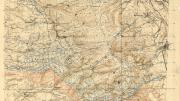The blue beauty at left is Porpita mediterranea rendered in glass, reproduced here at about twice life size. These jellies, moved by wind and wave across the surface of the open sea, are composed of colonies of specialized organisms. They trap and subdue their prey with tentacles bearing stinging cells that eject barbed threads with a paralyzing toxin, according to Janis Sacco, director of exhibitions at the Harvard Museum of Natural History. They don’t sting humans.


Harvard University Museum of Comparative Zoology
The University’s greatest indoor tourist attraction are the more than 4,000 astonishing “glass flowers” made especially for Harvard from 1887 through 1936 by artisans Leopold and Rudolph Blaschka, father and son, at their studio near Dresden. The plants now share the spotlight with sea slugs, squid, jellyfish, and other soft ones of the ocean, also rendered in glass and wire by the Blaschkas. The new exhibition Sea Creatures in Glass will continue through January 4, 2009. Alongside the 58 models are specimens in bottles, a video, and a recreation of the Blaschka studio.
Before they turned exclusively to plants, the Blaschkas mass-produced models of more than 700 marine invertebrate species. Harvard acquired its 420 models around 1878 to use for teaching. With the advent of underwater photography, the collection began to suffer from benign neglect (“The Glass Animals,” July-August 1997, page 92). “Most of the models still need to be cleaned and restored,” says James Hanken, Agassiz professor of zoology—a process to be completed, he judges, about $250,000 from now. A few of the first batch to be rescued were shown last year in Minnesota at Underwater Adventures Aquarium, whose CEO, Todd Peterson ’84, M.B.A. ’87, spurred Harvard’s efforts. The crystal creatures flew West in their own first-class seat on the plane.








